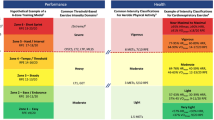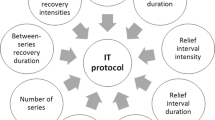Summary
Researchers, coaches and athletes have a variety of concepts of interval training, the only point of agreement being that interval training involves alternating bouts of exercise and recovery. The idea that interval training can be identified by a specific intensity, duration, or number of exercise bouts or by the amount or type of recovery between bouts of exercise is not valid. Rather, interval training has come to mean any type of intermittent training which, with manipulation of the number, intensity and duration of work bouts and amounts of recovery, is used to produce a particular type of stress on the body.
There is general agreement that rather specific guidelines are available which determine the amount and intensity of work and the amount of rest necessary to produce specific results, and it is suggested that types of training be identified based on the specific characteristics of each particular type of training rather than placing all types of intermittent training in an all-inclusive category called ‘interval training’.
Further efforts should be made to continue investigations which help determine how much, how often and for whom the various types of intermittent training are beneficial.
Similar content being viewed by others
References
Åstrand, I.; Åstrand, P.O.; Christensen, E.H. and Hedman, R.: Intermittent muscular work. Acta Physiologica Scandinavica 48: 448–453 (1960a).
Åstrand, I.; Åstrand, P.O.; Christensen, E.H. and Hedman, R.: Myohemoglobin as an oxygen store in man. Acta Physiologica Scandinavica 48: 454–460 (1960b).
Åstrand, P.-O. and Rodahl, K.: Textbook of Work Physiology, 2nd ed., pp.401–406 (McGraw-Hill Book Company, New York 1977).
Christensen, E.H.; Hedman, R. and Saltin, B.: Intermittent and continuous running. Acta Physiologica Scandinavica 50: 269–286 (1960).
Conley, D.L.; Krahenbuhl, G.S. and Burkett, L.N.: Training for aerobic capacity and running economy. Physician and Sports-medicine 9(4): 107–115 (1981).
DeVries, H.A.: Physiology of Exercise for Physical Education and Athletics, 2nd ed., p.242 (Wm. C. Brown Company, Dubuque, Iowa 1974).
Edington, D.W. and Edgerton, V.R.: The Biology of Physical Activity, pp.272–277 (Houghton Mifflin Company, Boston 1976).
Fox, E.L. and Matthews, D.K.: Interval Training — Conditioning for Sports and General Fitness, pp.21–30 (W.B. Saunders Company, Philadelphia 1974).
Jensen, C.R. and Fisher, A.G.: Scientific Basis of Athletic Conditioning, 2nd ed., p. 165 (Lea and Febiger, Philadelphia 1979).
MacDougall, D. and Sale, D.: Continuous vs interval training for the endurance athlete; in Patterson (Ed.) Sports Science Periodical on Research and Technology in Sport, pp. 1–7 (The Coaching Association of Canada, Ottawa, December 1980).
Saltin, B.: Intermittent Exercise: Its Physiology and Practical Application, pp. 1–15 (Ball State University, Muncie, Indiana 1975).
Tesch, P.; Piehl, K.; Wilson, G. and Karlsson, J.: Kanot, Idrottsfysiologi rapport nr 13, pp. 56–61 (Trygg-Hansa, Stockholm 1975).
Author information
Authors and Affiliations
Rights and permissions
About this article
Cite this article
Daniels, J., Scardina, N. Interval Training and Performance. Sports Medicine 1, 327–334 (1984). https://doi.org/10.2165/00007256-198401040-00006
Published:
Issue Date:
DOI: https://doi.org/10.2165/00007256-198401040-00006




